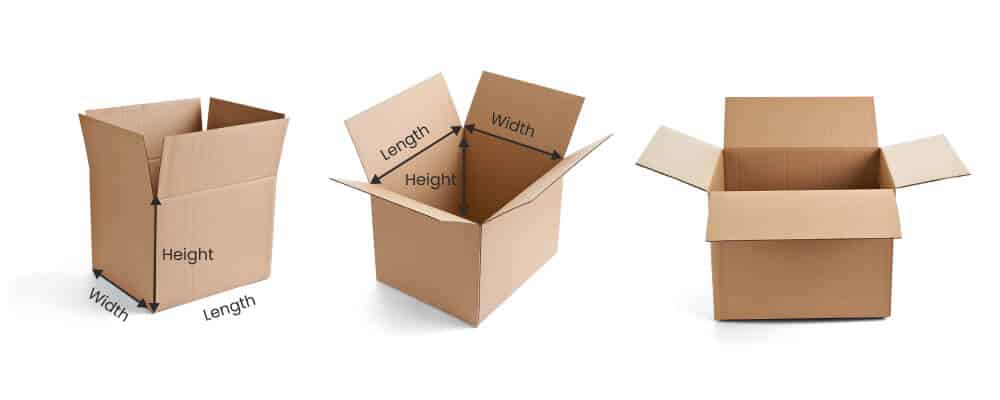When it comes to shipping packages, it’s essential to have accurate dimensions for your package in order to purchase accurate postage. This is where understanding the difference between inner and outer dimensions becomes crucial.
Inner dimensions refer to the dimensions on the inside of your package or box, while outer dimensions refer to the dimensions on the outside of your package or box. The difference between the two can be significant, up to half an inch for each measurement in some cases.
It’s not uncommon for box manufacturers to list the inner dimensions on the outside of the box, which can cause confusion when it comes to purchasing postage. If you enter the inner dimensions instead of the outer dimensions when purchasing postage, you may face carrier adjustments, such as Automated Package Verification (APV) charges from major carriers like FedEx, UPS, DHL, USPS, etc.
To avoid carrier adjustments and ensure accurate pricing, it’s important to always enter the outer dimensions of your package or box when purchasing postage. Major carriers have automated systems that verify the details of your package, including its weight, packaging type, and dimensions.
If the carrier’s system detects a discrepancy between the dimensions you entered and the actual dimensions of your package, you may be subject to additional charges.
Always double-check the dimensions listed on your package or box before entering them into a shipping platform like SFL WorldWide. Be sure to enter the outer dimensions to avoid carrier adjustments and ensure accurate pricing.
By understanding the difference between inner and outer dimensions, you can ensure a smooth and cost-effective shipping experience.

How To Take Box Dimensions & Measurements
If you want to produce the right-sized box for your product, it’s essential to know how to take accurate box dimensions and measurements. A simple mismeasurement can cause a costly and time-consuming setback to your packaging project.
Here are some steps you can follow to ensure you take accurate box dimensions and measurements:
Measuring the Interior Dimensions of a Box
To measure the interior dimensions of a box, position the unglued box in front of you, with the inside of the box facing up. Draw a line on the score lines where the box folds to create different panels. Mark the two scores that make up the length, width, and depth of the box.
Next, use a tape measure to measure the length between these scores to the nearest tenth of an inch. These measurements are used to calculate the interior dimensions of the box.
Measuring the Exterior Dimensions of a Box
Once you’ve packed and secured your box with the desired product inside, measuring the exterior dimensions is quite similar to the interior dimensions. With the box in front of you, use a tape measure to measure the length, width, and depth to the nearest tenth of an inch.
These measurements are used to calculate the exterior dimensions of the box.
Get Quote and Save UPTO 70% on your next shipping
Box Measurement Considerations
It’s important to consider that the measurements when the panels are flat are not the actual usable space in a box. Once the package is folded, and the flaps are in place, some of that space is occupied by the thickness of the material folding and creating the corners. The flaps also require some space when they are folded down.
The Overpacked Box
If you overpack a box and it bulges or expands beyond its normal dimensions, then the outside dimensions of the box for shipment would include the additional bulged dimensions.
The Thickness of the Box
The thickness of the material used to construct a box can indeed affect its outside dimensions. When a material with a certain thickness is used to create the walls of a box, that thickness must be taken into account when measuring the overall outside dimensions of the box.
For example, if a cardboard box has a thickness of 2 millimeters, and the dimensions of the box are listed as 10 cm x 10 cm x 10 cm, then the outside dimensions of the box including the thickness of the material would actually be 10.4 cm x 10.4 cm x 10.4 cm (assuming the thickness of the material is uniform throughout the box).
And if a cardboard box has a thickness of 3 millimeters, and the dimensions of the box are listed as 10 cm x 10 cm x 10 cm, then the outside dimensions of the box including the thickness of the material would actually be 10.9 cm x 10.9 cm x 10.9 cm (assuming the thickness of the material is uniform throughout the box).
The Final Note
Understanding the difference between the inner dimensions and outer dimensions of a box is essential for ensuring that your items are properly packed and shipped. While the inner dimensions refer to the space available inside the box, the outer dimensions take into account the thickness of the box’s material and any additional bulges caused by overpacking.
At SFL Worldwide, we understand the importance of proper packaging and shipping. Our team of experts can help you choose the right box and packing materials to ensure that your items arrive safely and securely at their destination.
Contact us today at +18006912335 to learn more about our shipping services and how we can help you with your next shipment.

SFL Worldwide is a top global logistics company delivering services in transportation, relocation, and freight forwarding. Since 2005, The company has handled domestic and international shipments. SFL helps its customers navigate through the complicated shipping regulations and documentation by providing professional advice. The company uses its network of 200+ partners to provide effective solutions to individuals and businesses. Its knowledge and experience give customers the assurance of safe, quick, and reliable global delivery, along with tracking available 24/7. Its ability to handle over 100,000 successful relocations worldwide is testimony to its reliability.



